Is Long Beach Bike Friendly Yet?
It has almost been three years since we first left Long Beach, CA to travel by bicycle. When we left, there was a lot of excitement about bicycling in Long Beach. The grassroots bike advocacy group I was part of was working hard doing bike valet throughout the city, giving monthly bicycle safety classes and attempting to get their non-profit status. There was excitement over the newly painted and controversial green-striped sharrow lane on 2nd Street, a high traffic commercial district. There was buzz over plans of a separated cycletrack in downtown. Long Beach was being touted as a shiny example of a bike friendly city in Southern California. Things were looking up. So it was with great interest when we visited Long Beach again this past week. We were excited to see how things have developed since we left. Was it finally living up to the big audacious goal that was hanging at the entrance of city hall?
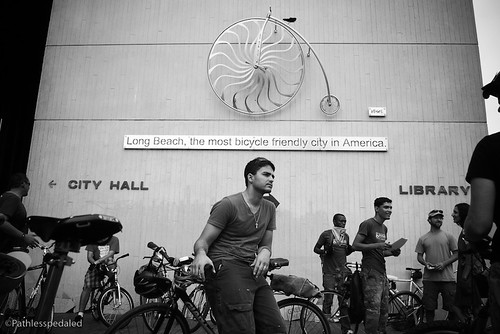
After a series of trains to get from the San Fernando Valley to Long Beach, our first stop was the new and supposedly permanent (this is its third location in a decade) location of BikeStation. Our friend Travis was there and gave us a tour. The structure is stunning with a ramp for members to wheel their bikes from the first floor to the 2nd floor members area. Hopefully, this will be its final location.
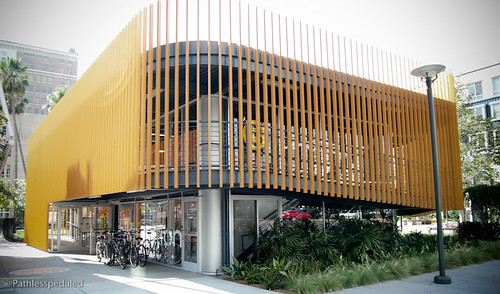
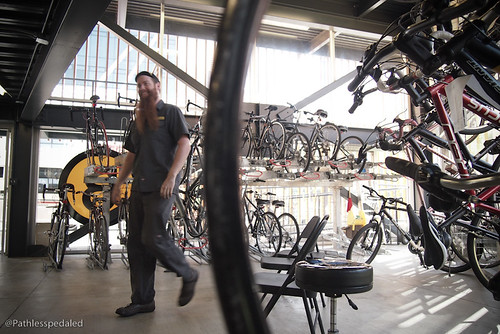
A good indicator of the health of bicycling in a city is its number of bicycle shops. To our surprise, two new bicycle shops have opened within the last four months. The Bike Connection is a new shop located on Long Beach Blvd. and Anaheim, a very unlikely place in Long Beach. With no infrastructure in sight and on one of the city’s main thoroughfares, it can be a challenging place for a cyclist to get to. However, it’s a bike shop in one of Long Beach’s under-served neighborhoods. Bike Connection carries some new cruiser and fixed gear bikes, but its specialty is used frames and repairs for local residents. There is a range of old cruiser bikes, English 3 speeds, and even a few touring bikes.
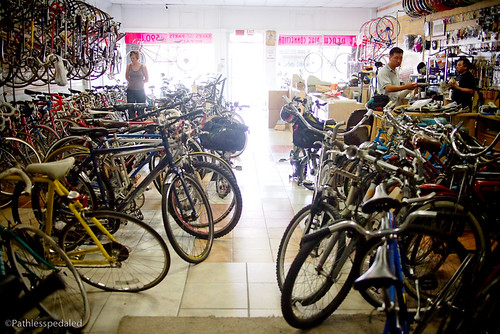
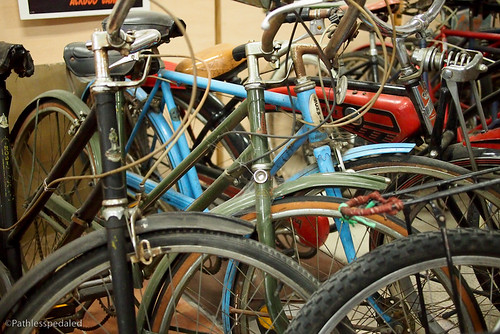
The other new bicycle shop is The Workshop, in the Bixby Knolls area of Long Beach. Again, it’s in an area with little bike infrastructure, but has a strong walking community. If a cyclist in Bixby Knolls needed a repair or wanted to buy a bike, they would have to drive many miles to the nearest bike shop – now they have access to a bike shop on their main street. We chatted a little with Graham Baden, the manager of the shop. Residents have been supportive, and he has been busy with repairs as people bring in bikes that have been collecting dust in their garages. The most rewarding part of the new business, he tells us, is seeing local residents riding bikes that he has repaired. Currently, they carry a selection of fixed gear bikes and skateboards, but has plans to carry more commuting bicycles and gear.
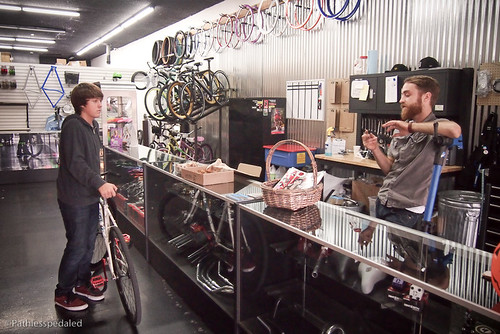
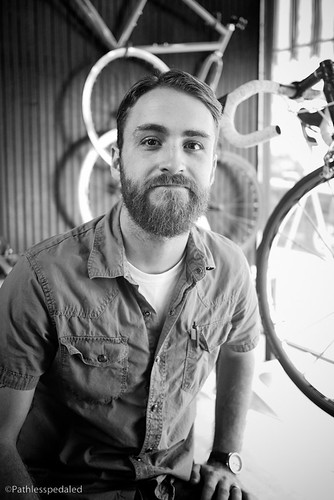
Bixby Knolls is also part of Long Beach’s Bicycle Friendly Business District program. We spoke with April Economides, the city consultant in charge of developing and implementing the program. Four distinct areas in Long Beach (Bixby Knolls, 4th Street, Little Cambodia, East Village) are participating. As participating districts, each one is given a cargo bike, as well as regular bicycles, to be used by the local business district to promote cycling within the district. Businesses are also encouraged to participate during Bike Saturdays and provide those who arrive by bike with some discounts on food and merchandise (we got a free cup of coffee at It’s A Grind in Bixby Knolls). We spoke to April about interacting with the businesses and some of the challenges she faced. She told us some business owners didn’t know or weren’t aware that many of their customers arrived by bike. They had the preconception that only people driving to a business district would spend money on goods and services. However, through lots of public outreach and direct interaction with business owners, she has been able to convert skeptical business owners. What is unique about the BFBD (Bicycle Friendly Business District) concept is that it phrases the potential economic impact of cycling in no uncertain terms. One of April’s long term goals is to develop a blueprint for other business districts to follow.
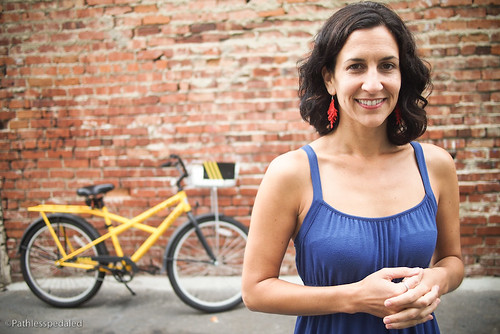
While it is too early to tell if the BFBD program is a success, it certainly has attracted lots of attention and will hopefully plant the seed in the heads of other bicycle advocates around the state and country to make alliances with business districts. One of the specific challenges in Long Beach is that, of the four districts, only two of them (East Village and 4th Street) are easily navigable by bike (and, even at that, the actual street of 4th is not the most pleasant to ride on!). The other districts are in areas which have very fast or busy traffic and no bike amenities. Which leads to another potential problem, how sustainable is the program? April hopes that the businesses will continue to build the bicycle friendly districts long after the funding for the grant has expired. Her hope is that it will be self-sustaining, and she has done her due diligence by engaging all stake-holders and getting them involved. Time will tell if they continue to be bicycle friendly districts in the future.
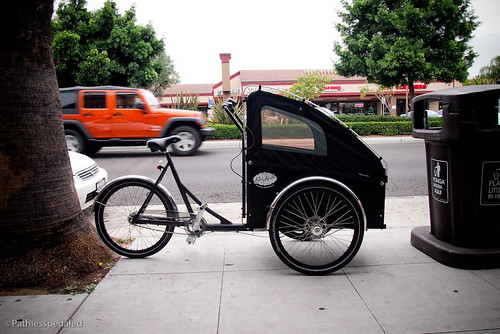
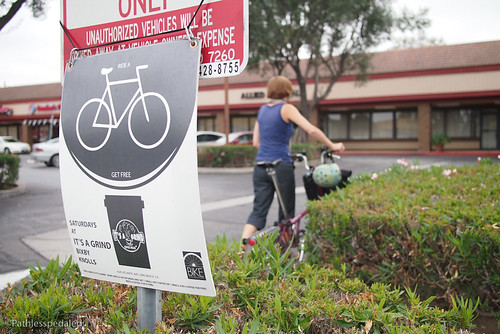
During our visit, we rode around and sampled all the infrastructure we could find. Long Beach has improved since we started riding bicycles and we did seem to notice more people on bikes. There are the green sharrows on 2nd Street and the much touted cycletrack through downtown. Neither are perfect, but they do seem to attract more riders. I will say, to our surprise, we STILL found many people riding on the sidewalk on 2nd Street and in the door zone despite the big green stripe.
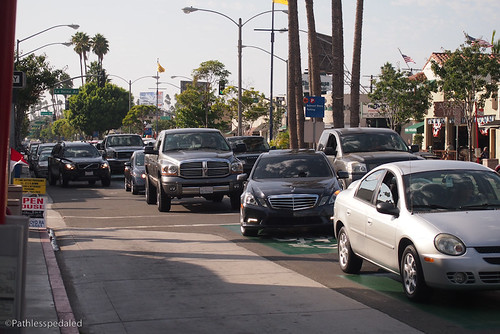
I rode the cycletracks and found them to be an inviting experience. However, they are not without problems. There was a section where giant slippery steel plates were in the middle of the lane, creating a hazard for cyclists (which have apparently been there for months). There are also many points of potential turning conflict with the unprotected driveways, as well as how the paths themselves (while pleasant) end abruptly with no way-finding to connect to other bike friendly streets. Assuming that it is meant for less experienced cyclists, some instruction as to what to do after the path ends would be helpful.

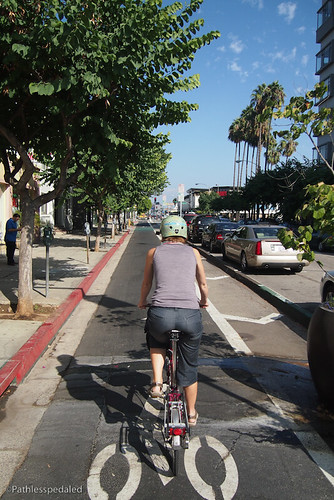
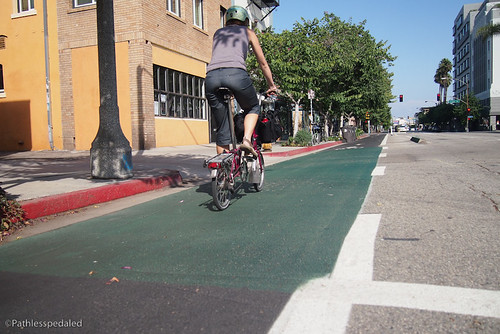
We did see many things that the city did right, like the placement of sharrows around town. We also noticed that the Passport bus, one of the most used buses in the city, finally had bicycle racks on them. There were also some numbered bicycle route signs to be found, spread sporadically through the city. However, from what I understand, there is still no city bike map that shows the numbered route system. We tried to diligently follow one and, when we weren’t getting lost, we were getting disappointed because many of the traffic sensors STILL did not recognize bicycles at intersections.


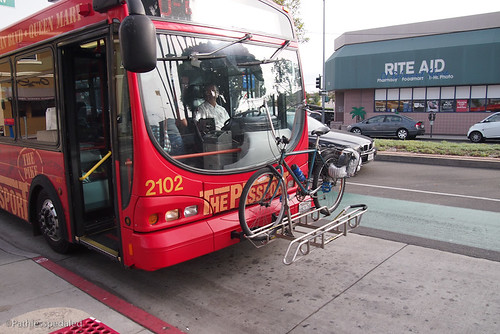
For Long Beach, the devil is in the details – or, rather, in the missing details. There is a cycletrack, but a portion of it has dangerous steel plates and no way-finding where they end. There are numbered routes, but the intersections don’t recognize bikes. There is infrastructure, but no education of drivers, cyclists or law enforcement. With the green sharrows, the cycletrack, and Bike Friendly Business Districts, Long Beach has achieved some good things and has pushed some boundaries for which it should be commended, but I believe it can do better. I also believe it can do better without having to always resort to high-profile, innovative infrastructure all the time. It’s sort of like attempting to do a 360 degree slam dunk from the free throw line before mastering the basic layup.
Take, for example, fixing traffic sensors so they recognize cyclists at lights, especially on signed bike routes. There is nothing more degrading than not being recognized by a lifeless unblinking machine – and it doesn’t take any special permits, millions of dollars of federal funding and hiring consulting firms to fix the problem. Another inexpensive way to foster a bike friendly city is to have a BPAC (Bicycle and Pedestrian Advisory Committee), made up of all interested stake holders. By inviting those that want to be involved and truly listening to their wants and needs, it would eliminate the rancor and in-fighting that often develops when people feel unheard and unimportant. Furthermore, if there was a BPAC, there would be constant pressure to make incremental improvements and be accountable, rather than just a flurry of high profile projects every few years.
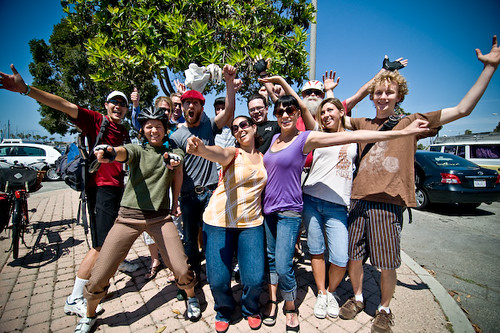
When we went back, I was a little heartbroken to hear that the Long Beach Cyclists, the grassroots bike advocacy group I had been a part of, had dissolved their board and was no longer active. Not that I can blame them. When I was with them, I constantly felt like we were between a rock and a hard place. We were always struggling to get our voices heard by the city. Slowly, I saw people who gave so much, so willingly, get angry, disenchanted, and then burn out.
Long Beach has made some great strides and has attracted a lot of attention with its high profile projects. Many cities have even begun to look to Long Beach as a leader in bicycle friendliness. I challenge the city to continue to work toward its goal to be the most bike friendly city in the country, by not just working on infrastructure projects, but also by giving cyclists a seat at the table when it comes to decision making. Being a bike-friendly city not only means having cycletracks, but also supporting and listening to the rich and diverse bicycling community. That’s a bike project has been overdue in Long Beach for a long time.
6 Comments
Leave a Reply to April Economides
This site uses Akismet to reduce spam. Learn how your comment data is processed.
Subscribe
Patreon
Join Team Supple on Patreon
PayPal

You should email the city cycling dept your web page. Let them read your advice / suggestions for improvements. I think they would find it helpful to make use of your vast cycling experience and on road expertise. Lead them to the water and hope they drink.
I live in N. OC right next to Long Beach and agree with the sidewalk comment. I have seen more people here riding on the sidewalk than any other place I’ve lived. Even with bike lanes, I think the lack of education mixed with the fear of cars makes people choose the sidewalk regardless of lanes.
Also, I’ll have to check out the Bike Connection. It looks like a really cool shop!
Russ,
Thank you for your thoughtful story and coverage of the BFBD program. Similar to how Burnside in Portland is not bike-friendly but the city created the lovely adjacent bike blvd, I think (I hope!) the city is looking to do the same in Bixby Knolls with the roads parallel to Atlantic. I’ll bring your compelling BPAC idea to the attention of Allan Crawford, the city’s new bike coordinator.
It’s always great to have bike experts in town, and your and Laura’s observations are important for Long Beach.
Ride on,
ae
I really think cops should enforce the laws against riding on sidewalks and against traffic. So many times I am out there taking the lane and right next to me another cyclist is riding on the sidewalk. It makes me look foolish to cars since I feel they think I should be off the street and the sidewalk too. The people that ride on the street against traffic (I call them Salmon), really are dangerous too other cyclists and themselves.
Another good post Russ!
Thank you Russ and Laura for visiting the city and giving your thoughtful and constructive views on why this town continues to struggle without a clear vision of the way ahead. You are right on target about advocates ‘burning out’ because the city can’t seem to engage them honestly nor empower cyclists and citizens to drive the agenda.
It is a bummer that LB Cyclists gave up just as the tide is turning in the city. Following the course of other activist groups that have dissolved (Ecolink) or just become muted (Sierra Club LB Chapter and Surfrider) just as they gain relevance. I am sure that activists in the Northwest or Minneapolis are far more resilient. Southern California and LB in particular is a black hole for civic culture.